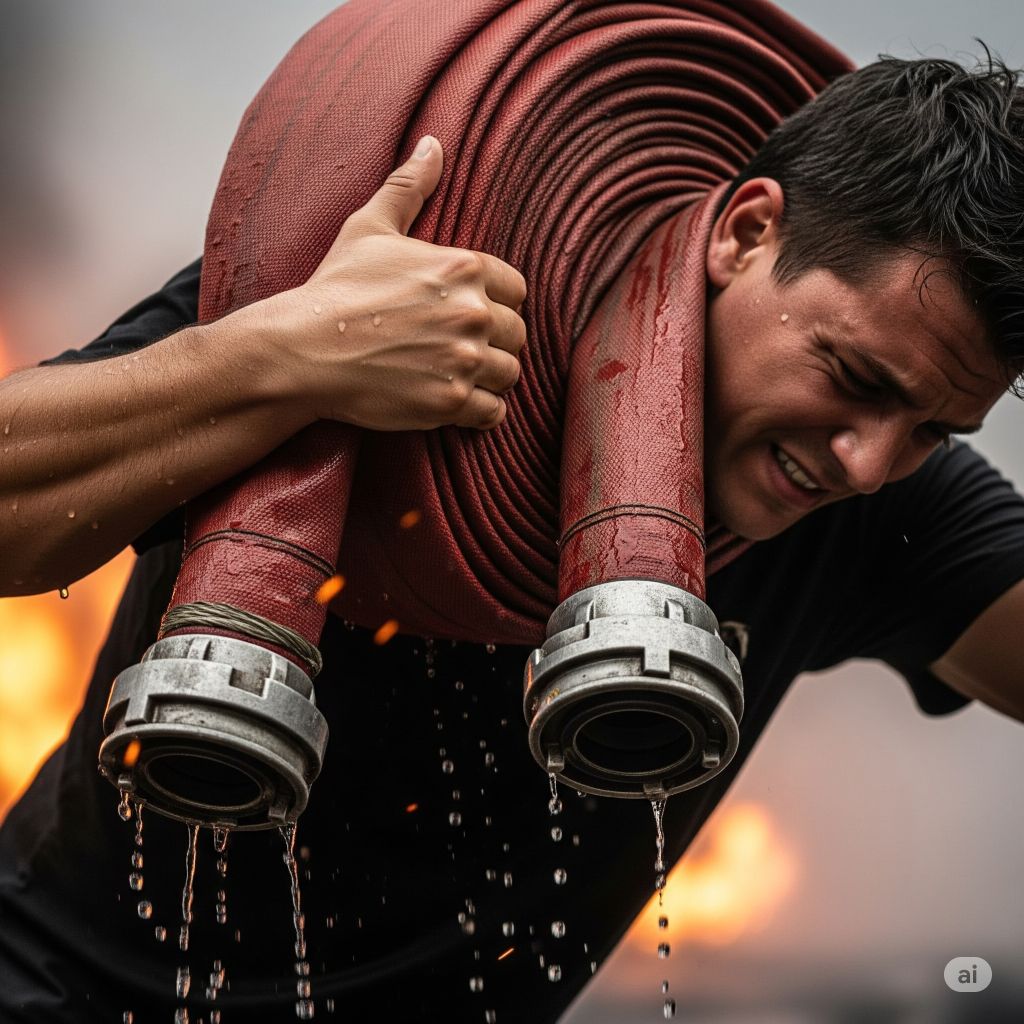
When we think of firefighting, images of courageous men and women battling flames with powerful water streams often come to mind. One critical yet overlooked part of that image is the fire hose—a vital tool in fire suppression. But what many people don’t realize is just how heavy fire hoses can be, especially when filled with water. The weight of fire hoses significantly impacts firefighter performance, fatigue, mobility, and overall safety.
This article dives deep into fire hose types, weight factors, challenges firefighters face, and how departments adapt to the physical demands these tools create.
🚒 Understanding Fire Hose Types and Sizes
Fire hoses come in different sizes and types, each designed for specific functions in firefighting. Here’s a breakdown of the most common ones:
1. Booster Hoses
- Diameter: 0.75 to 1 inch
- Use: For small fires or overhaul operations
- Dry Weight: ~20–30 lbs per 50 ft
- Filled Weight: ~50–60 lbs per 50 ft
2. Attack Hoses
- Diameter: 1.5 to 1.75 inches (most common)
- Use: Interior fire attack
- Dry Weight: ~18–28 lbs per 50 ft
- Filled Weight: ~75–85 lbs per 50 ft
3. Supply Hoses
- Diameter: 2.5 to 5 inches
- Use: To supply water from hydrants to engines
- Dry Weight (5” hose): ~100 lbs per 100 ft
- Filled Weight (5” hose): 900–1,000 lbs per 100 ft
4. Forestry Hoses
- Diameter: 1 to 1.5 inches
- Use: Wildland firefighting
- Dry Weight: ~10–20 lbs per 100 ft
- Filled Weight: ~80–100 lbs per 100 ft
⚖️ Fire Hose Weight: Dry vs. Charged
A major factor in firefighter load is the difference between a dry hose (no water inside) and a charged hose (filled with pressurized water). Here’s how much heavier they get:
| Hose Size | Length | Dry Weight | Filled Weight | Water Weight Alone |
|---|---|---|---|---|
| 1.5″ attack | 50 ft | ~20 lbs | ~75–85 lbs | ~55–65 lbs |
| 2.5″ attack | 50 ft | ~30–40 lbs | ~120–130 lbs | ~90–100 lbs |
| 5″ supply | 100 ft | ~100 lbs | ~900–1000 lbs | ~800–900 lbs |
Note: 1 gallon of water weighs ~8.34 lbs; 50 ft of 1.75″ hose can hold ~6–8 gallons of water.
💪 Physical Strain on Firefighters
Carrying and maneuvering a charged fire hose is one of the most physically demanding tasks in firefighting. Here’s why:
1. Weight Distribution
- A 50 ft charged 1.75” hose weighs over 80 lbs.
- Firefighters must manage this weight while in full gear, which adds another 45–70 lbs.
2. Mobility Challenges
- Dragging hose upstairs or through debris-filled structures limits speed.
- The resistance from high-pressure water makes advancing the hose even harder.
3. Fatigue and Injury Risk
- Prolonged hose operations can lead to:
- Muscle strain
- Lower back pain
- Heat stress
- Slips and falls due to poor footing or fatigue
🦺 Safety Implications of Hose Weight
The weight of fire hoses affects both firefighter safety and operational effectiveness:
1. Risk of Falls or Entanglement
- Heavy hoses can catch on furniture, debris, or staircases.
- Poor hose management can lead to trip hazards for team members.
2. Slower Interior Attack
- Heavier hoses are harder to reposition quickly.
- In fast-moving fires, delays can endanger trapped occupants or fire crews.
3. Backdraft and Flashover Hazards
- Slower movement increases exposure time to intense heat and toxic smoke.
- Hesitation or struggle with a hose during entry can lead to being caught in a flashover.
🧰 Equipment and Training Adaptations
Fire departments and hose manufacturers continually look for ways to reduce strain and improve efficiency:
1. Lightweight Hose Materials
- Newer hoses use synthetic fibers and thinner linings to reduce dry weight.
- Some brands have reduced hose weight by up to 20–30% compared to older rubber-jacketed versions.
2. Two-Person Hose Handling Techniques
- Firefighters are trained to:
- “Pinch and push” with one firefighter bracing the hose
- Use stair belts or hose straps for control
- Coil or flake hoses for smoother deployment
3. Use of Hose Roller Tools or Reels
- Hose carts and mechanical rollers help in reloading large-diameter hoses.
- Some engine companies use hydraulic-assist tools to load 5” supply lines.
4. Hose Carrying Harnesses
- Specialized harnesses help distribute hose weight evenly across shoulders.
- Commonly used for high-rise packs and long hoseline advances.
🧯 Real-World Examples
- High-Rise Fires: Carrying 200 ft of 2.5″ hose up 10 floors can mean lugging over 500 lbs of equipment (including SCBA and tools).
- Wildland Fires: Even though forestry hoses are lighter, long hikes, heat, and altitude can make carrying even 20 lbs a major challenge.
- Rural Water Supply: Volunteer firefighters often deploy thousands of feet of 3–5” hose, sometimes dragging them across fields without hydrants—requiring ATVs or even manual hose lays.
📊 Summary Table: Fire Hose Weights (Common Sizes)
| Hose Type | Diameter | Length | Dry Weight | Filled Weight |
|---|---|---|---|---|
| Booster Hose | 1″ | 50 ft | 25 lbs | ~60 lbs |
| Attack Hose | 1.75″ | 50 ft | 20–25 lbs | ~80 lbs |
| Attack Hose | 2.5″ | 50 ft | 35–40 lbs | ~120 lbs |
| Supply Hose | 5″ | 100 ft | 100 lbs | ~950 lbs |
| Forestry Hose | 1″ | 100 ft | 10–15 lbs | ~90 lbs |
🧠 Final Thoughts
The weight of fire hoses is more than just a number—it’s a crucial factor that influences:
- Firefighter endurance
- Operational speed
- Injury rates
- Fire attack effectiveness
Modern firefighting continuously evolves to mitigate the physical toll with better materials, tools, and training. Still, hose handling remains one of the toughest and most important skills a firefighter must master.
🔥 Fire Hose Weight – FAQs
1. How much does a standard fire hose weigh?
A typical 1.75-inch attack hose weighs about 20–25 lbs dry and up to 80–85 lbs when filled with water per 50-foot section.
2. Why does a fire hose get so heavy when filled?
Water weighs 8.34 lbs per gallon, and hoses can hold several gallons depending on size. A 2.5″ hose filled with water can weigh over 120 lbs per 50 ft.
3. Do firefighters carry the hoses themselves?
Yes. Firefighters must often carry or drag charged hoses through buildings or up stairs while wearing 45–70 lbs of gear, increasing fatigue.
4. What’s the heaviest type of fire hose used?
The 5-inch large-diameter supply hose (LDH) is among the heaviest. A 100-foot section filled with water can weigh nearly 1,000 lbs.
5. Are there lighter versions of hoses available?
Yes. Newer hoses made from synthetic materials and streamlined inner linings reduce dry weight by 20–30% compared to traditional rubber-jacketed hoses.
6. How do firefighters manage the weight when deploying hoses?
Firefighters use two-person teams, hose straps, stair belts, and training techniques like the “pinch and push” to safely control and advance heavy hoses.
7. Is the weight of hoses a major cause of injury?
Yes. Strains, back injuries, and slips/falls are common due to heavy, water-filled hoses—especially in tight or smoke-filled environments.
8. Does hose weight affect how fast firefighters can attack a fire?
Absolutely. Heavier hoses are harder to maneuver, slowing down interior attacks and increasing exposure time to dangerous conditions like flashovers or toxic smoke.
9. How much water does a 50 ft 1.75” hose hold?
Roughly 6–7 gallons, which adds about 50–60 lbs of water weight, not including the hose itself.
10. Can equipment help reduce the strain of hose handling?
Yes. Tools like hose rollers, carts, carrying harnesses, and even motorized hose assists are used to make handling large or long hoses more manageable.
